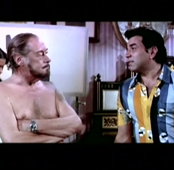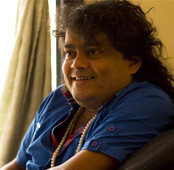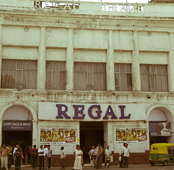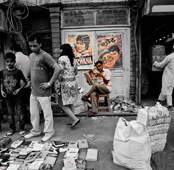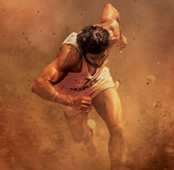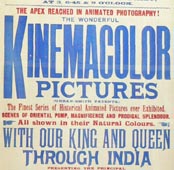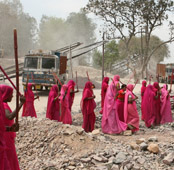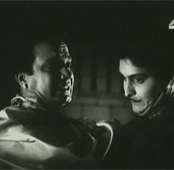-
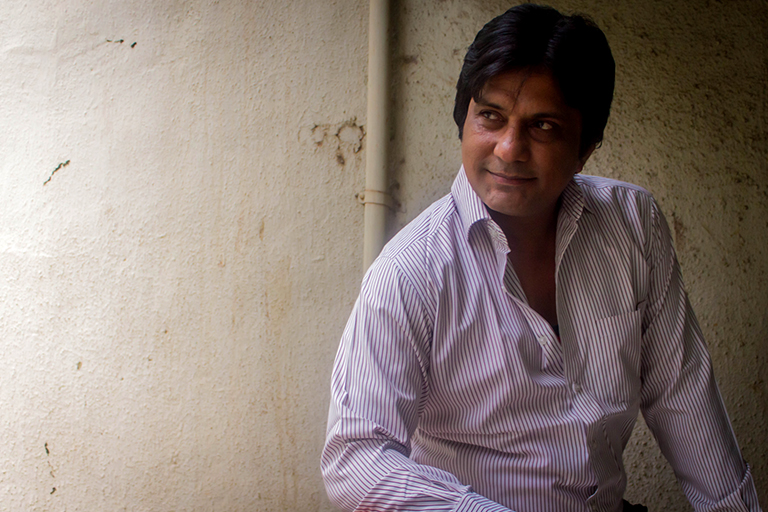 Firoz Khan halfway through towards becoming Amitabh Bachchan, Shantenu Tilwankar for TBIP
Firoz Khan halfway through towards becoming Amitabh Bachchan, Shantenu Tilwankar for TBIP -
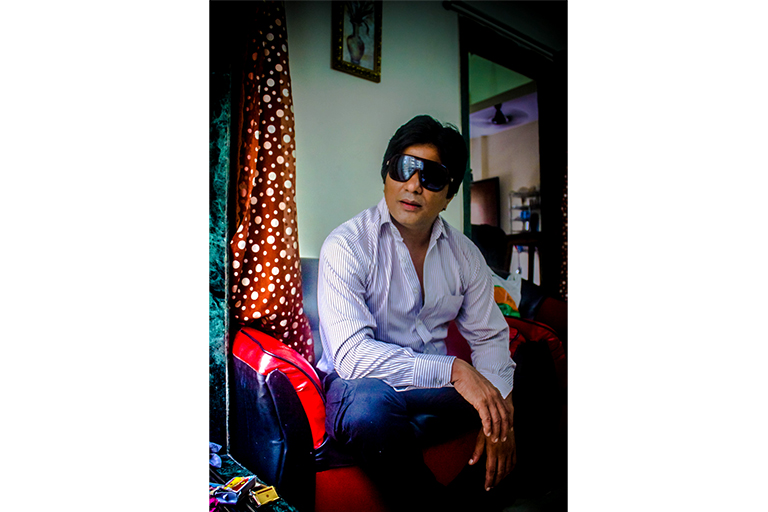 Firoz gearing up for the photo-shoot, Shantenu Tilwankar for TBIP
Firoz gearing up for the photo-shoot, Shantenu Tilwankar for TBIP -
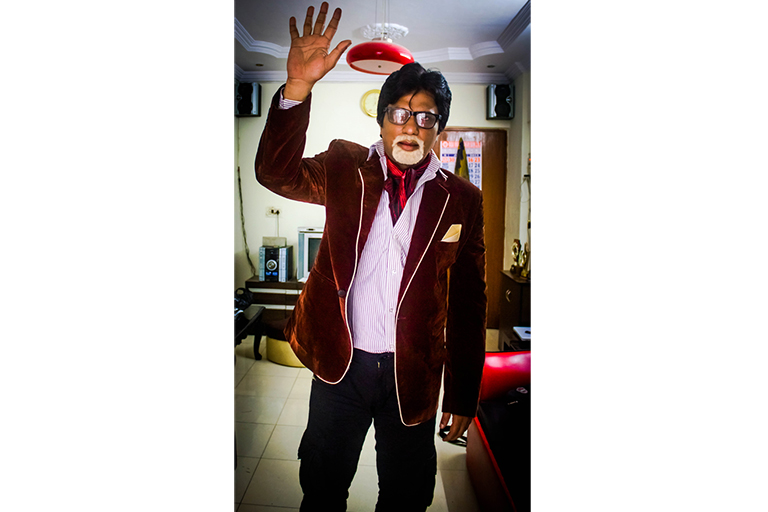 Firoz spontaneously posing when a camera is pointed towards him, Shantenu Tilwankar for TBIP
Firoz spontaneously posing when a camera is pointed towards him, Shantenu Tilwankar for TBIP -
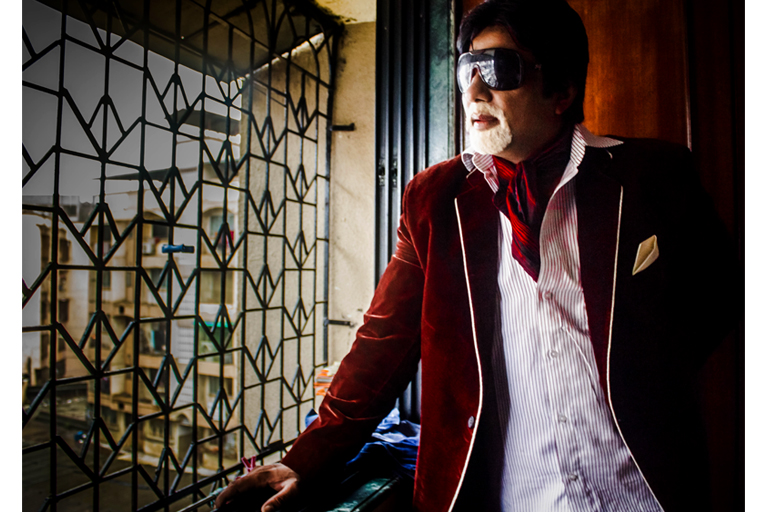 Firoz in his Bachchan avatar, Shantenu Tilwankar for TBIP
Firoz in his Bachchan avatar, Shantenu Tilwankar for TBIP -
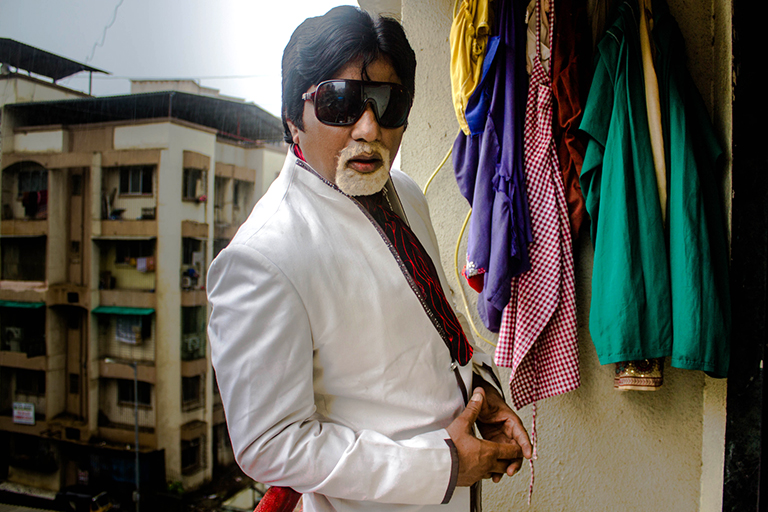 Firoz posing in his own balcony, Shantenu Tilwankar for TBIP
Firoz posing in his own balcony, Shantenu Tilwankar for TBIP -
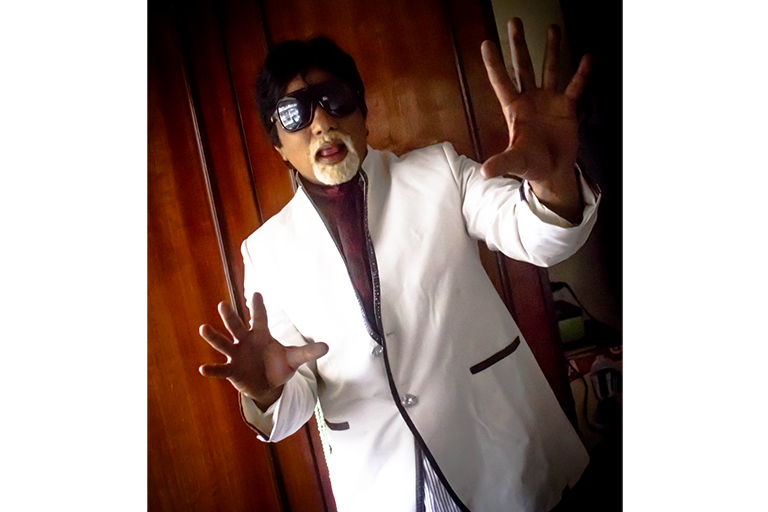 Firoz posing in his bedroom, Shantenu Tilwankar for TBIP
Firoz posing in his bedroom, Shantenu Tilwankar for TBIP -
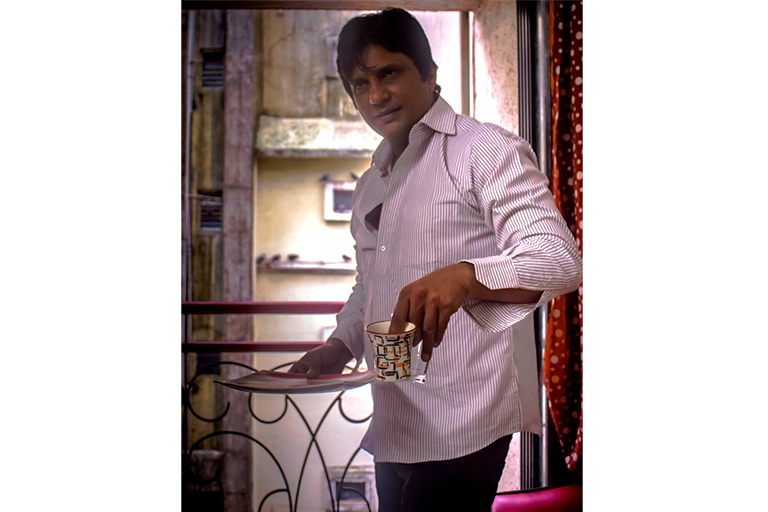 Firoz in a candid moment, Shantenu Tilwankar for TBIP
Firoz in a candid moment, Shantenu Tilwankar for TBIP -
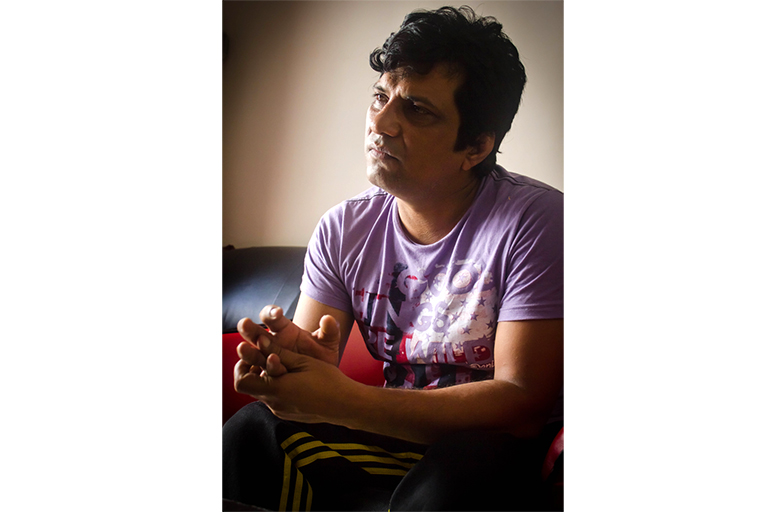 Another candid moment, Shantenu Tilwankar for TBIP
Another candid moment, Shantenu Tilwankar for TBIP -
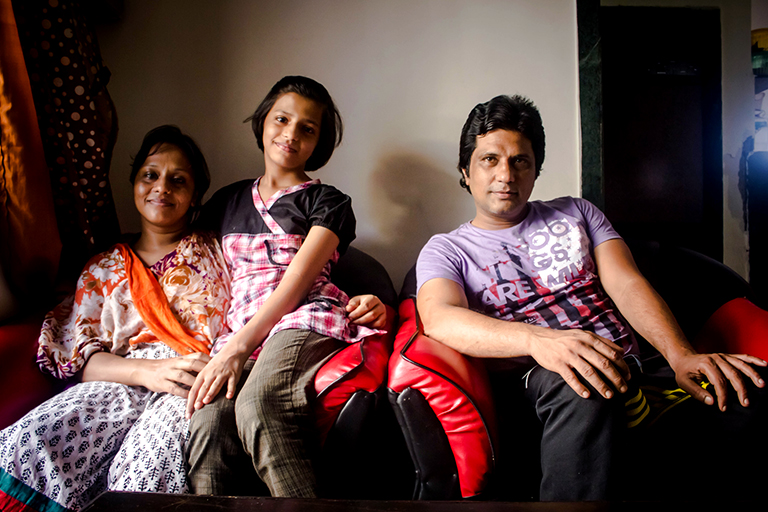 Firoz with his wife, Rana, and daughter, Tuba, Shantenu Tilwankar for TBIP
Firoz with his wife, Rana, and daughter, Tuba, Shantenu Tilwankar for TBIP -
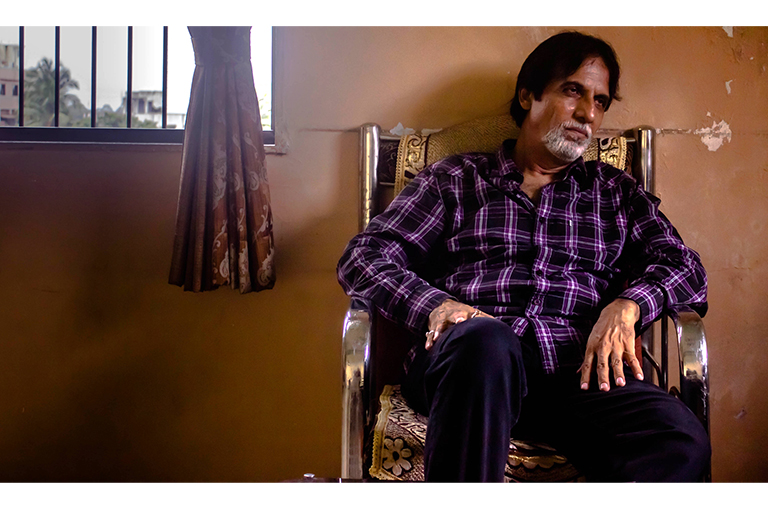 Rajkumar Bakhtiani at his house at Ulhasnagar, Shantenu Tilwankar for TBIP
Rajkumar Bakhtiani at his house at Ulhasnagar, Shantenu Tilwankar for TBIP -
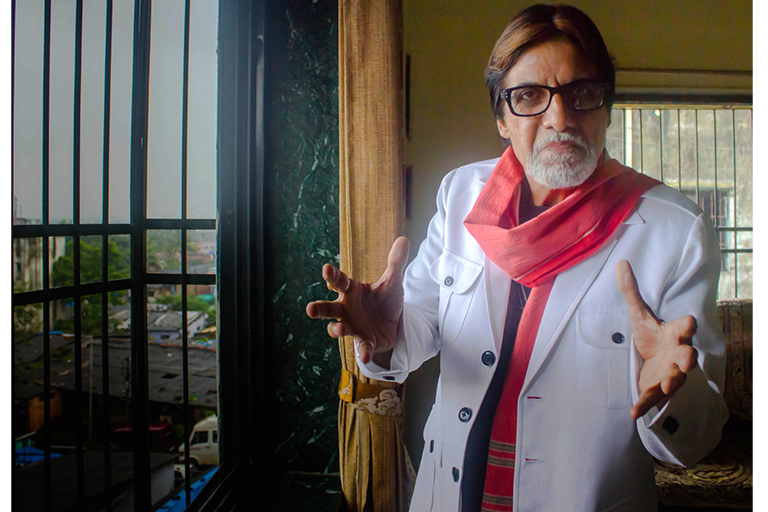 Rajkumar as Amitabh Bachchan, Shantenu Tilwankar for TBIP
Rajkumar as Amitabh Bachchan, Shantenu Tilwankar for TBIP -
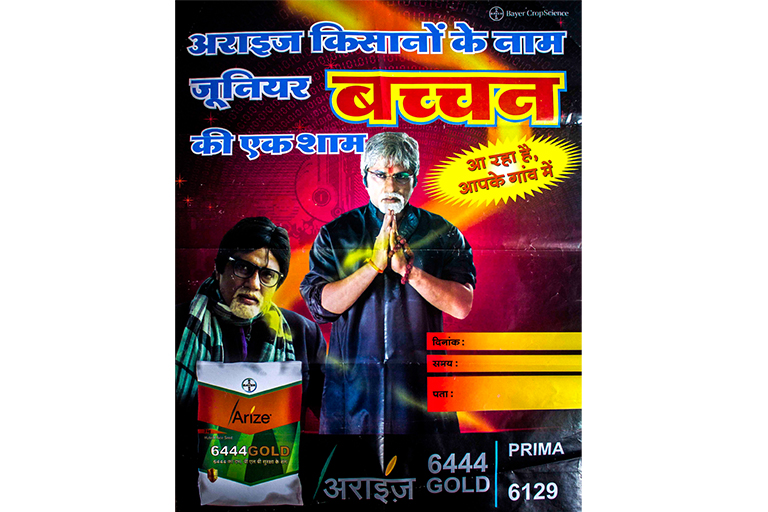 A poster of Arize 6444 Gold
A poster of Arize 6444 Gold -
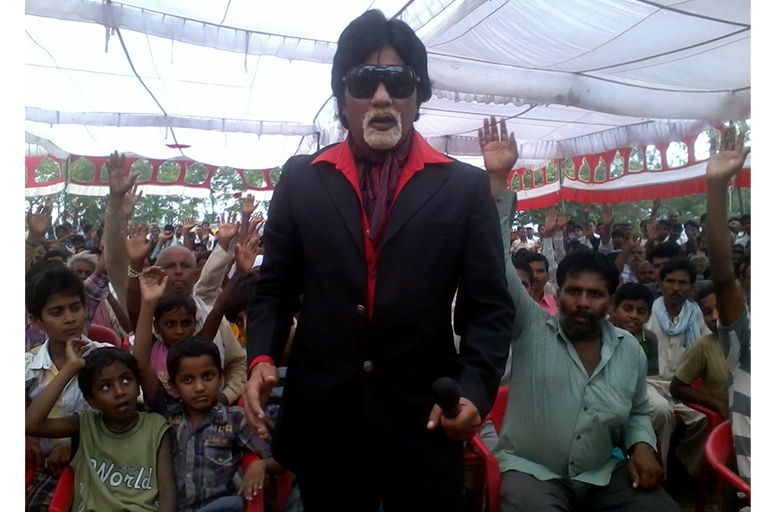 Firoz surrounded by fans after a live show
Firoz surrounded by fans after a live show -
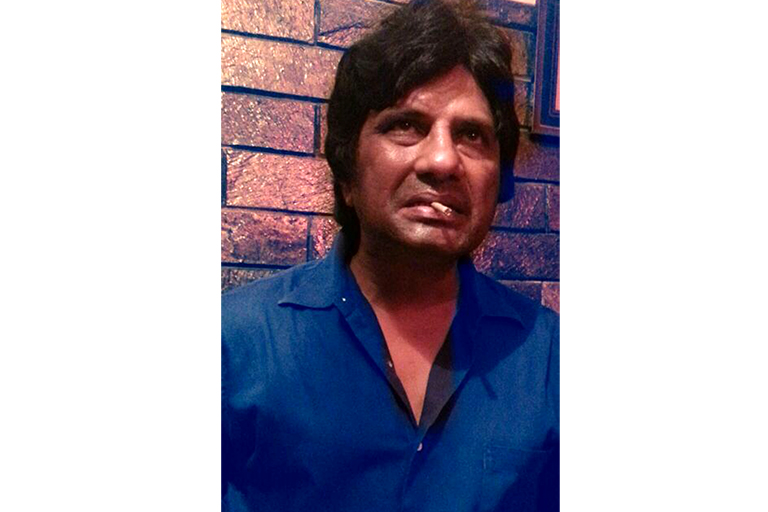 Firoz impersonating Amitabh Bachchan from Deewaar
Firoz impersonating Amitabh Bachchan from Deewaar -
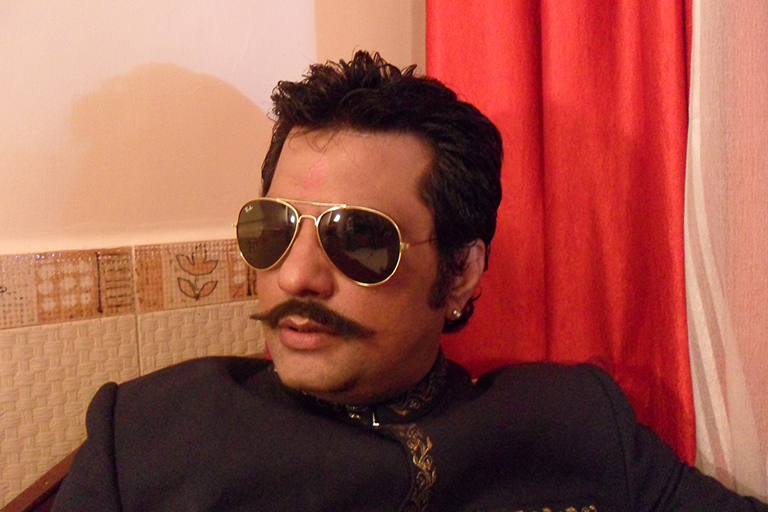 Firoz as Randhir Singh Chaudhary in the serial Rehna Hai Teri Palkon Ki Chhaon Mein
Firoz as Randhir Singh Chaudhary in the serial Rehna Hai Teri Palkon Ki Chhaon Mein -
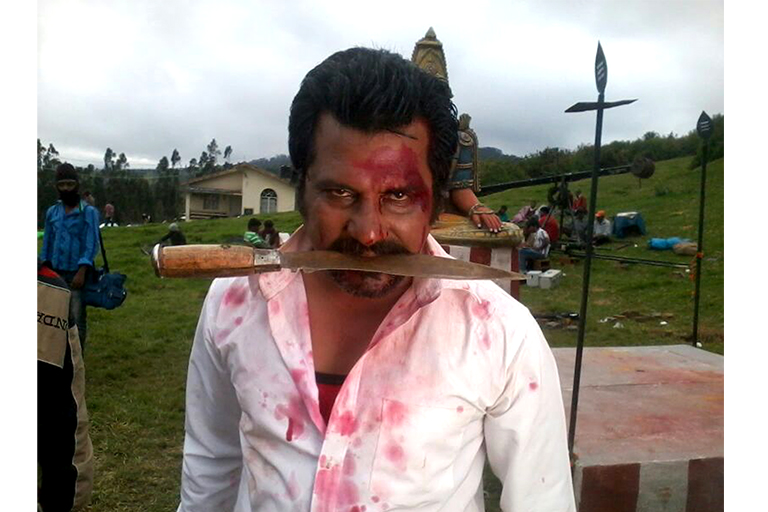 Firoz as J. K. in the movie Nandeesha
Firoz as J. K. in the movie Nandeesha
Firoz Khan has made a name for himself as the nation’s most popular Amitabh Bachchan lookalike. But his greatest gift is also his prison.
When Firoz Khan stood tall on a makeshift stage in Jaunpur, Uttar Pradesh, this June, there was no one around. His only companions were a microphone, two speakers, some chairs lying vacant and a multitude of banners surrounding him that read: “Arize kisaanon ke naam Junior Bachchan ki ek shaam (An evening of ‘Junior Bachchan’, dedicated to the ‘Arize farmers’)”.
Not far away from the stage was a bazaar, bustling with people. This absolute lack of any attention seemed to discomfit Firoz. Moments later, his voice boomed on the microphone: “Bhaiyon aur doston, meri jahan tak awaaz jaa rahi hai, mera kisaan bhaiyon se kehna hai ki yahan aa kar humaare program ko dekhne ki koshish karein (Brothers and friends, if my voice is reaching you then I want to ask my farmer brothers to come here and try to watch my show).”
Slowly, people began to trickle in. The voice seemed to draw them closer to the microphone. A rich, commanding voice. Most significantly, a voice whose familiarity is emblazoned into the subconscious of every Indian moviegoer. The denizens of Jaunpur were curious. They inched closer to the stage to answer an incredible question: What was Amitabh Bachchan, one of India’s biggest superstars, doing on this unremarkable afternoon in their town?
As the sun beat down on him, while he recited iconic dialogues from Bachchan’s movies to regale his audience, Firoz felt a searing pain that ran from his feet to his lower back. The pain was not new to Firoz. Because, when he impersonates Bachchan, his feet are not planted firmly on the ground. To rise up to Bachchan’s six feet and one inch a five feet and eight inch tall Firoz wears an inch-and-a-half of rubber padding under each foot. The padding raises his heels, slants his toes and invariably causes pain. Over time, he has learnt to live with it.
In 30 minutes, by the time Firoz had concluded his act, he was surrounded by more than a thousand people who refused to leave. They wanted to be near him, speak to him, ask for his autograph, touch his feet. By now the pain was heightened, but he also found it was easier to endure.
***
‘Arize’ is the name of a brand of rice seed manufactured by the Bayer Group, a German chemical, pharmaceutical and bio-technology multinational. Besides Firoz they have used popular singers Gurdas Maan and Altaf Raja, and Bhojpuri stars Manoj Tiwari and Ravi Kishan to market their products to the Indian heartland. For Firoz, this is only one of over hundreds of shows he has done, for hundreds of clients.
There are over a dozen Amitabh Bachchan lookalikes in the market, but Firoz has been in it for the long run. He has not only impersonated Bachchan for 16 years, he has done so across a whole spectrum of media— besides live shows there have been over 40 movies, 10 spoof and dance shows on television, 30 ad films and 8 music videos. TV shows such as Koffee with Karan, Boogie Woogie, MTV Fully Faltoo and Ek Do Teen. Music videos such as the one for Adnan Sami’s popular song Lift Kara De where the actor Govinda appeared as himself and Firoz appeared as Bachchan. Firoz has been Bachchan in TV commercials for AXE Deodorant as well as one for the Income Tax Department, asking conscientious Indians to file their returns on time. In Cadbury Dairy Milk’s ‘Pappu Pass Ho Gaya’ ad, Firoz was Bachchan’s body double. He played himself, a Bachchan lookalike, in Chandan Arora’s Main Madhuri Dixit Banna Chahti Hoon (2003). In Danny Boyle’s Oscar winning Slumdog Millionaire (2008), he played Bachchan.
***
“I am not a ‘Amitabh duplicate’,” says Firoz, leisurely climbing the stairs to reach his apartment, a one-bedroom-hall-kitchen on the third floor of a building in Mira Road, one of Mumbai’s more far-flung suburbs. “There are many lookalikes whose only job is to look like him. I don’t look that much like him. I act him out. You can call me more of a performer.”
That Firoz does not, at first glance, look like Bachchan, is true. He’s wearing a denim-shirt, a little tight around the stomach, and a pair of black cotton trousers with six pockets. But, when you look closely, certain similarities emerge. Deep set eyes, though Bachchan’s are much larger. A prominent nose. A wide forehead. An oval face with a well-defined jawline whose effect, for Firoz, has been diminished to some degree by an emerging double chin. He has a thick head of hair, parted from the left, it curls up along the sides, covering a portion of his ears.
A few minutes later, Firoz sprawls out on a black and red Rexine couch in his living room. The only window in the room is partially veiled by faded brown curtains with white and faded orange polka dots. It faces a five-storied building whose walls are covered with black fungus. Besides the couch, the living room is furnished with two red and black single-seater sofas, two small granite topped side-tables, a tiny closet and another table with a 17 inch TV and a stereo system. On one of the side-tables lie a couple of stray match sticks and a golden packet of chewing tobacco labelled ‘Miraag Tambako’ in Hindi. The other side-table has a laptop and two plastic containers full of medicines. The closet top doubles up as yet another table, displaying various trophies Firoz has received. One small trophy has a circular plaque, broken along its rim, with a picture of Amitabh Bachchan from the film Sarkar (2005). On its base are inscribed the words: “Sattarvein janamdin par sa prem bhent (A gift, with love, on your 70th birthday). Nataani Medical Hall.”
Firoz will turn 45 this year.
He lights a cigarette and does a Shah Rukh Khan impersonation. “Arre yaar kaisi baat karte hain aap, haan (What are you talking about)?” The slightly nasal, hurried voice of the Shah Rukh of the 90s. He cocks his head to one side for effect. During the course of conversation, Firoz breaks off to demonstrate his skills many times. He mimics his effeminate male friend, a street ruffian with a gruff voice, and, of course, Amitabh Bachchan: “Dekhta kya hai be? Ulte haath ka maarunga. Saala samajhta kya hai tu apne aap ko? (What are you looking at? I’ll slap you hard. What do you think of yourself?)” Away from the stage, in the comfort of his living room, when Firoz impersonates Bachchan he does not mouth off the superstar’s famous dialogues— he simply says anything he wants to, the way Bachchan would.
But for the padding in his shoes, Firoz’s metamorphosis into Bachchan is not really an elaborate process. He flares his nostrils, curls his upper lip and modulates his voice. “I just put on a wig, a French beard, do my hair like Amit ji, and that’s it,” he says, looking around for the wig. He relies very little on make-up. “What can you do with make-up? What will happen with powder?”
Finding the wig, he leaves the room to reappear in a few minutes. His hair is parted from the middle now, with a few strands falling on his forehead. He’s wearing sunglasses and a velvet scarf around his neck. A white shirt with blue stripes and an off-white blazer. His black trousers fall perfectly on a pair of boots that have heels that are at least an inch high. These give Firoz a considerably raised appearance. His gaze, barely visible through the sun glasses, is quiet, relaxed, self-assured. He seems to be smiling without actually doing so. He does not look like the actor on the fringes that he is. He seems to have found his highest calling.
In the building opposite, a little girl peers out of the window. She freezes for an instant, then breaks into a giggle and covers her face with a small notebook.
***
Amitabh Bachchan’s family name is actually Srivastava. ‘Bachchan’, which the renowned poet Harivansh Rai—Amitabh Bachchan’s father—chose as his pen name, and which became the family name thereafter, is actually colloquial usage in Uttar Pradesh for the eldest son of a family. Firoz too was the eldest among his three brothers. “All of them would call me Bachchan,” he says. “Aur Bachchan Bhai (What’s up Bachchan?)” was how he was addressed.
Firoz watched his first Amitabh Bachchan movie, Khoon Pasina (1977), in his native town, Budaun, in Uttar Pradesh, at the age of 10. In Budaun, people would collect just to stare at the posters of a Bachchan movie, put up outside theatres, 15 days before its release. Inside, they would hoot every time Bachchan appeared, throw money at the screen, dance on their seats or in the aisles.
It was after Khoon Pasina that Firoz began frequenting the theatres. Soon his friends began to say “The way you are talking right now, you look like Amitabh” or “We can see glimpses of Amitabh in you”. Then, one day, Firoz found himself in front of a mirror, mimicking Bachchan.
But it wasn’t until he was 15 that Firoz imitated Bachchan in front of others. It was when he had just emerged from the theatre after watching Deewaar. He had already begun to style his hair like Bachchan and model his gait and mannerisms on the superstar. He would stop at the paan shop and asked for a paan— not in his own voice, but in Bachchan’s. “A crowd soon gathered around,” says Firoz. “They were probably seeing something like this for the first time.” Since then, Firoz didn’t have to bother paying for paan or cigarettes at that shop. Firoz recalls the shopkeeper saying: “You stand here and do your thing. Seeing you, four to five more people come to my shop.” Soon, he began doing impersonations at other venues in town: a school, his house, his relatives’ weddings. “People would queue up in front of my house to hear dialogues of Amit ji,” he remembers. “I thought, even I am becoming something yaar.”
Determined to become an actor, Firoz decided to head to Bombay. But in a small town like his cinema was not seen as a worthwhile profession. Because cinema was a world which had “a lot of nangapan (nakedness).” “My father had not seen a single movie in his life. In fact, he could never get himself to pronounce Amitabh Bachchan properly,” Firoz says. “The closest he got was, ‘Amita ka Bachchan’.”
So Firoz ran away from home—from Budaun to Bombay—when he was 21. The year was 1990. But he stayed for just about a fortnight before heading back. He ran away to Bombay again after two years. He didn’t stay long then either. Firoz would rather not talk about those days. His younger brother, Parvez, says: “He left for Bombay in anger. Both times he was in Bombay for 15 to 20 days, till he ran out of money.”
Meanwhile, in 1991, actor Vijay Saxena had begun drawing a lot of attention for looking like Amitabh Bachchan after he did the movie Ramgarh Ke Sholay. Saxena followed this up with nine movies in just three years, playing the role of a Bachchan lookalike in most of these. But, in 1994, his career was cut short by a fatal road accident.
Firoz reached Bombay for the third time, on January 1, 1995. “I thought that the first thing I would do after reaching Bombay was meet Amit ji,” he says. “But, after I reached, things turned upside down. Bombay is so huge, I wouldn’t ever know where he was. So I wasn’t able to reach the locations where he was shooting. Instead, I would stand in front of his bungalow and wait to catch a glimpse of him.”
This time Firoz hadn’t come to Bombay alone. Accompanying him was his friend, Laal Shehazwani from Budaun, who had also come to Bombay to become an actor.
This time he stayed. Tired of waiting outside Bachchan’s bungalow he began looking for work instead. He spent months attending auditions, despite being rejected each time, sleeping at the railway stations and being shooed away from there by policemen. Finally, he met a shopkeeper from Budaun, who allowed him to sleep in his shop, in exchange for Firoz helping out with some accounts work.
Then, one evening, Firoz was passing by Kurla when he chanced upon a sign for what seemed to be a show by lookalikes. He went in to watch. One of the organizers announced: “Presenting to you the duplicates of Dharmendra and Anil Kapoor.” Firoz saw an opportunity.
He went backstage and told the organizer, Shakdeev (Firoz only remembers his first name) that he could “impersonate Amit ji really well”. Shakdeev was not entirely convinced. Firoz wasn’t very tall. He didn’t really look like Bachchan either. Firoz pleaded with him to let him demonstrate on stage “just for a minute”.
He stayed on for more. During those crucial few minutes Firoz stole the show. The audience burst out into applause. “I was better received than all the lookalikes who had performed before me.” After the show Shakdeev said to Firoz that he would get a suit made— just for him. Just like the one Amitabh wore then. “Also,” said Shakdeev. “I will get you high-heeled shoes.” And so it was settled. He was paid Rs 300 for every show.
But it was a year after this, in 1997, that he got his first real break. Actor and director Sachin Pilgaonkar cast him in a countdown-comedy show called Rin Ek Do Teen, which he had auditioned for. The show spoofed Bachchan’s biggest hits. The names of the films were tweaked for each episode. Muqaddar ka Sikandar became ‘Muqaddar ka Kalandar’, Deewaar became ‘The War’, Sholay became ‘Go-lay’. Firoz shot 52 episodes. He soon began getting calls for live shows outside Mumbai. Not for Rs. 300, but “30 times that amount”. He wasn’t going back to Budaun.
“In those days I used to feel like a superstar,” says Firoz. “Sets were being readied for me; cameras were being readied for me.”
He adds: “And all the films were being made for Firoz.” On the heels of Ek Do Teen, came a plethora of B-grade movies like Phool aur Aag (1999), Duplicate Sholay (a spoof on Sholay, 2002), Gangobai (2002), and Kabhi Kranti Kabhie Jung (2004), in most of which Firoz played a Bachchan lookalike.
Even among the overkill of Bachchan lookalikes today, Firoz holds sway. This is made evident in an episode of the TV show Entertainment Ke Liye Kuch Bhi Karega, judged by Farah Khan and Anu Malik. There are two Bachchan lookalikes, a ‘younger’ Amitabh Bachchan played by Firoz, and an ‘older’ Bachchan played by an actor named Rajkumar Bakhtiani. In the brief trying-hard-to-be-funny-but-tepid conversation that ensues, it’s clear who has more finesse. Rajkumar’s voice lacks the ring of the famous Bachchan baritone. It is overly solemn at times, and his portrayal of Bachchan’s mannerisms are simply not remarkable. Firoz, on the other hand, not only sounds eerily like Bachchan, he also seems to have seamlessly imbibed into his act Bachchan’s pauses, his gaze, the way the actor’s voice trails off after a robust dialogue, even his comic timing.
***
Firoz finally met Bachchan in 1999, on the sets of Kohram (released in August, the same year), 22 years after he first saw him on screen. Bachchan on screen had left him awestruck but standing before the man himself Firoz was overwhelmed by nervousness and joy. His hands trembled as he shook hands with the star. “I was scared and kept thinking about how he would react, what he would say,” he says. He had been imitating Bachchan effortlessly for 17 years, but in front of him, “I was trying to do something else, yet something else was happening.” At the end of the whole episode, Firoz felt “as if I was flying”.
Any lookalike’s career trajectory depends on the trajectory of the person he is imitating. His career runs parallel to that of the object of his impersonation. From 1995 to 1999, Bachchan himself seemed to be going through an identity crisis of sorts. He had returned to the movie business at the age of 53 and found he could no longer be the ‘angry young man’ that had made him India’s biggest star. This realization had been preceded by a spate of embarrassing, mediocre films such as Mrityudaata (1997) and Lal Badshaah (1999). Bachchan’s fortunes finally turned with Kaun Banega Crorepati (also called KBC, the Indian version of Who Wants To Be A Millionaire) that established him as what is possibly the nation’s first older star icon. He cemented this with a role in Mohabbatein (2000) directed by Aditya Chopra who had cast him not as a ‘character actor’ (which in those days still meant that he would merely play out a stereotype on screen, for roughly one-twentieth of the film’s running time) but in a well-etched pivotal part that had almost as much screen-time as the film’s lead actor Shah Rukh Khan.
Bachchan was not the only one to benefit from this turning point. “KBC benefitted me too,” says Firoz. “When I did MTV Fully Faltoo; there used to be episodes spoofing Kaun Banega Crorepati called ‘Kaise Banoonga Crorepati (How Will I Become A Millionaire) ’,” says Firoz.
Being associated with a big name in the incestuous Mumbai film industry provides a unique advantage to any aspiring actor. Firoz had no godfather but being associated with the biggest name of them all, however obliquely, helped. “He got in pretty easily with the help of Amitabh,” says Rana, Firoz’s wife. “He would have had to struggle a lot as Firoz.”
Says Firoz’s competitor Rajkumar: “Due to Bachchan Saab I’m able to make a living. His level of success affects that of us lookalikes.” He had given up on acting for nearly a decade before KBC signalled his return. “It’s quite clear that had there been no KBC, I wouldn’t have made a comeback either.”
***
Yet today, 16 years after his first big break with Ek Do Teen, Firoz can’t help but wonder if it would have been better if he had struggled, as Firoz.
“My initial interest was to do roles of different types,” he says. “That did not happen. Amit ji was so famous that once they got to know about this talent of mine, this is all they wanted me to do. But I have so many talents they are not even aware of. They don’t want to see those.”
He adds: “I am fully confident that even in front of Amit ji, I can act as Firoz. I would have no hesitation, no fear.”
So there are two Firozes. One, who is grateful for the breaks he has got, and one who rues each of them.
In an attempt to reconcile the two, he defends his impersonations: “Even if I enact Amitabh, I do it in my own style, which allows me to show so many things that Amit ji might not have done. I mix my comedy and Amit ji’s comedy.”
Also, he says: “Acting as oneself, which so many Indian actors do, is the easiest thing in the world. But being someone else is so much more difficult. Remembering his dialogues, his expressions, how he walks, carrying all those things within you… That’s a double pressure. I don’t have to do all of this while acting as myself, or even while building a character from scratch.” He adds: “You see some artists in a serial, but then you don’t know where they have disappeared. They just come and go. At least I am not like them.” This is his strongest argument so far.
Firoz’s friend, Laal Shehazwani, who had come from Budaun to Bombay with him to become an actor, has long since gone back. He tried his luck as an Akshay Kumar lookalike but gave up on his acting aspirations and left the city in four years. Now he runs a property trading business in Budaun. “A duplicate can only work as a duplicate. They will not be able to do their own acting,” says Laal. “Firoz’s identity in Bombay is as an Amitabh duplicate. He doesn’t have an identity of his own.”
Even as Amitabh Bachchan managed to reinvent himself, to become more than Bachchan, with his comeback in a series of powerful but understated character parts in the 2000s, Firoz has not been able to exorcise himself of Bachchan.
Firoz admits that, of the 40 odd films he did, those that didn’t cast him as a Bachchan lookalike had him play roles that were just as stereotypical, the most common one being that of a dacoit. (In fact, wherever Firoz has not played Bachchan, he has gotten a negative part. He puts this down to his voice which he feels “is very impactful in negative roles”.) “There was nothing to do in these movies,” he says. He was new to the industry when he signed on this spate of tacky films, made by likes of directors such as Kanti Shah (the king of the Indian B movie industry). “There was a lack of respect. I couldn’t make sense of the story. They did not do things in an ‘artistic’ fashion.”
Then, suddenly, there is an outburst: “If people ask me, ‘What did you do of your own?’ I would tell them, ‘I would tell you what I can do once you put me in front of the camera.’ Give me a chance at least.”
As you spend time with Firoz, you realize suddenly why he doesn’t need to mouth dialogues from Bachchan’s films to sound like the star did in the eighties. Firoz has played Bachchan for so long, he has become ‘Bachchanesque’. In the usual course of his life he sounds like the angry young man Bachchan isn’t any more. Like an actor stuck in the middle of a biopic that was canned.
He claims he still did these films because: “I did not want to sit idle. Those movies helped me take care of my family.”
When he was finally offered a ‘good role’, a film with Rajpal Yadav (a noted character actor) with a good six to seven minute part that required him to act not impersonate, he had to pass it up. “I couldn’t do the movie because I was stuck in a live show on the date.” A live show impersonating Bachchan.
***
Occasionally Firoz has managed to step out of the mould. He acted in 10 episodes of a Star TV serial Saath Nibhaana Saathiya, where he played a feudal lord, and around 40 episodes of NDTV Imagine’s Rehna Hai Teri Palkon Ki Chhaon Mein, where, again, he played a troublemaker.
Komal Kumar, a Kannada actor and producer, had cast Firoz as a Bachchan lookalike for the Kannada movie Radhana Ganda, released this year. After the shoot, Firoz said to Komal: “Bhaisahab (Brother), without Amitabh Bachchan ji also, I can act.”
“I could see that he was very spontaneous and quick,” says Komal. So, in his film Nandeesha, released in December last year, Komal cast Firoz as ‘J. K.’, a villain in his own right, who has 25 to 30 minutes of screentime. “I am planning to cast him in another movie too,” Komal says. “I will be giving him a Hindi lecturer’s character. When Firoz was acting as J. K., not in a single frame was he seen as Bachchan. He was a different Firoz.” If this role of a lecturer, his first non-negative role, works out, it may be a new beginning.
***
Firoz’s 8 year old son, Faiz, is sitting just a few feet from us, in the living room, watching Transformers on TV. When he was younger he had mistaken Firoz for Amitabh Bachchan. He had seen his father in one of his performances, and Bachchan on TV, and had been unable to tell the difference. “When he grew older, one day, he said to me: ‘But papa, this is not you’. I made him understand that I do mimicry, that this is also one kind of a work.”
Firoz wants a movie to be made on his life— “Showcasing both my lives, as Amitabh and as Firoz. You know, those ‘different’ kind of movies? I want to tell them— this is my height. I want to tell them how I become Amitabh, how I wear those high heeled shoes. How it pains. How, when my show gets over, I go back to my room and put my feet in hot water. I want everyone to know who lookalikes are actually. They think all lookalikes are the same.” Firoz feels there is only one person in India who can make such a movie: “Aamir Khan. Only if someone like him makes that movie, will it have the necessary impact.”
***
He shows me a photograph of himself as the feudal lord he plays in Saath Nibhaana Saathiya. He is wearing a pathani and has a moustache that is twirled at the ends.
“As ‘J. K.’ in Nandeesha, my face looks like a dog.” Firoz has stood up all of a sudden, his back straight as a rod. His eyes glare at the wall in front of him. “Randhir Singh Chaudhary bolte hain mereko (They call me Randhir Singh Chaudhary),” he says, in a threatening voice.“Is poore ilaake ke andar kisi mein utni himmat nahin ki Randhir Singh ki taraf ankh utha kar bhi baat kar sake (There is no one in this area who has enough courage to look Randhir Singh in the eye).”
He laughs menacingly. He turns towards me, vigorously running his hands through his hair. “If I do my hair like this,” he asks. “Will anyone say I look like Amitabh?”
The Mirror Cracked
ArticleOctober 2013
 By Tanul Thakur
By Tanul Thakur
Tanul Thakur is Junior Correspondent at The Big Indian Picture



